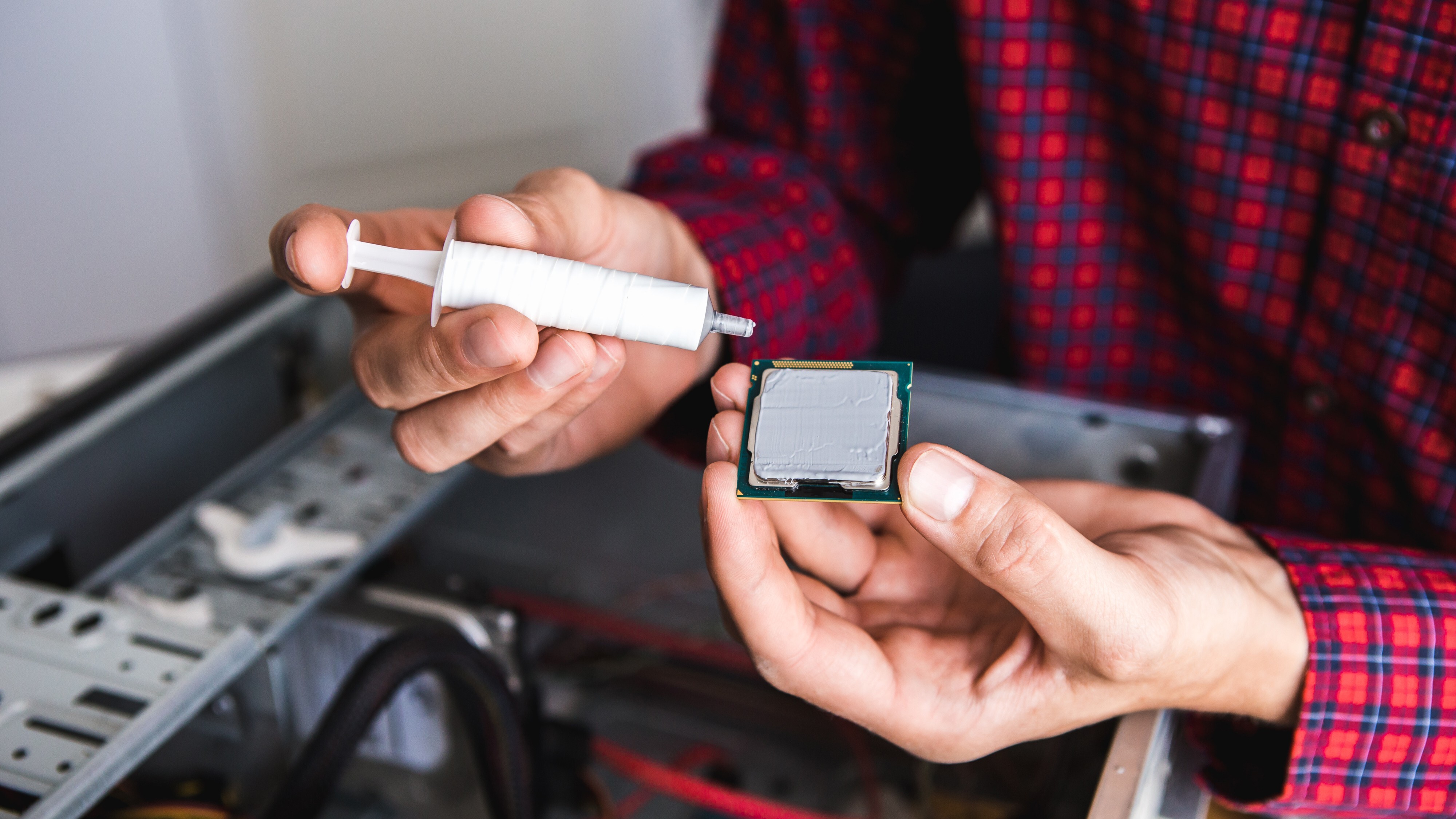Stinky thermal paste emits acidic vapors, corrodes copper, 'glues' heatsinks to processors, and permanently damages coolers - SGT-4 TIM is a chemically reactive blend, finds investigation
Or enjoy the vinegar odor, because you like marinated pickles, and pitting because you like ant videos.

Some thermal pastes are good for air cooling, others for liquid cooling, some are generally efficient, others are not. But as our colleague Igor Wallosek discovered, there is a thermal paste that stinks and damages coolers. That thermal paste — Amech (Aimac) SGT-4 made in South Korea — appears to be quite popular in online stores around the world because it is cheap and gets favorable user reviews. Yet, SGT-4 appears to be a chemically reactive blend that stinks due to acidic vapors, permanently damages CPUs and coolers with pitting from corrosion, and causes coolers to glue to the chip. The TIM also doesn't meet its thermal ratings due to the pitting.
SGT-4 (not among the best thermal greases that Tom's Hardware has tested) is based on PMDS; however, chemical testing and user evidence indicate that it is not a standard silicone-based thermal paste, as it adds a reactive acetoxy-curing RTV silicone, a substance that seems to release acetic acid when it contacts moisture, based on Igor's findings. This additive — likely methyltriacetoxysilane, according to Igor's Lab — was apparently used to make the grease cohesive and adhesive when applied at thin bond lines, but its reaction produces acidic vapors that cause metal oxidation and the smell of vinegar.
During operation, the acetic acid gradually corrodes copper surfaces, causes pitting and discoloration, and glues surfaces together, according to both Igor and his readers. Although the substance glues the cooler to the CPU, Igor Lab's measurements found that thermal conductivity was far below the manufacturer's claims, probably due to pitting (called 'ant nest corrosion') caused by the acid. Normally, thermal greases are applied to fill in the imperfections of the surfaces of the cooler and the cooled system, thus enhancing cooling performance. This appears not to be the case with the SGT-4, as instead of filling the voids, it creates new ones.
Community posts on Quasarzone — a South Korean website — confirm a host of problems, such as erased CPU markings, copper discoloration, and pitting on copper. Despite the fact that Amech prefers to be an incognito 'brand' with no website, users from South Korea have found a way to contact it.
The manufacturer's reaction was not exactly supportive: instead of addressing the evidence, Amech representatives issued personal insults, dismissed the findings as baseless, and insisted the product complied with RoHS and REACH environmental standards that prove that the grease does not contain any hazardous substances. Meanwhile, such certifications are irrelevant to metal reactivity or being precursors of hazardous substances, especially under normal usage conditions.
To make matters even worse, the Amech reps repeatedly referred to Igor's unveilings as 'a person from Germany' to discredit the source while avoiding any technical rebuttal. They have never disclosed the paste's composition either. As a result, by mid-October, trust in the company had collapsed completely among the community.

Follow Tom's Hardware on Google News, or add us as a preferred source, to get our latest news, analysis, & reviews in your feeds.
Get Tom's Hardware's best news and in-depth reviews, straight to your inbox.

Anton Shilov is a contributing writer at Tom’s Hardware. Over the past couple of decades, he has covered everything from CPUs and GPUs to supercomputers and from modern process technologies and latest fab tools to high-tech industry trends.
-
Heat_Fan89 Unless you are a builder then quality thermal paste is low cost. I also stick with name brand TP, like Thermal Grizzly or Arctic paste. There are many others but spending $6 for a tube of high quality paste is not going to break the bank for most DIY's. Cheapying out on thermal paste is like buying the lowest cost PSU for your build.Reply -
Mindstab Thrull Reply
It might be worse than that. A bad PSU will still keep your computer functional, though maybe not optimally so. One might think the errors are elsewhere, such as bad memory. A bad cooling setup, you can tell fairly quickly when your CPU idles in the high 80s or worse, and it shuts down easily.Heat_Fan89 said:Unless you are a builder then quality thermal paste is low cost. I also stick with name brand TP, like Thermal Grizzly or Arctic paste. There are many others but spending $6 for a tube of high quality paste is not going to break the bank for most DIY's. Cheapying out on thermal paste is like buying the lowest cost PSU for your build. -
Notton For direct die TIMs, such as on laptops and GPUs, I recommend Iceburg Thermal FuzeIce Plus and Thermalright TFX.Reply
They are highly viscous and application takes a bit more care, but they are resistant to thermal pump out, so you don't have to reapply it every year, if at all.
Honeywell PTM7950 would be my general recommendation for any application, if you know the product is not a counterfeit or copy. -
edzieba Sounds like a catalysis-cure (as opposed to addition-cure) Silicone with some conductive particles mixed in. Perfectly valid for industrial applications not a good idea for electronics. Not would any thermal adhesive (regardless of composition) be a good idea for CPUs in the first place.Reply -
Dntknwitall The crazy thing is that this thermal paste is expensive if you compare it Arctic MX-4 paste. It is same price or more in some online stores. I wouldn't buy it just for that reason, if I can get tried and true thermal solutions for the same or less cost I will definitely stick to them. Although I have tried thermal paste fro BASF and it is pretty competitive to arctic. But my other thought is did this company not even test their own product for quality? This is why people have trust issues in the consumer PC environment.Reply -
bit_user Reply
I agree with @Mindstab Thrull that they're not comparable. It's generally not unsafe (i.e. risking damage) to go with low-quality cooling components, but that can't be said for some PSUs.Heat_Fan89 said:Cheapying out on thermal paste is like buying the lowest cost PSU for your build.
However, I agree with the rest of your post, which is basically that it's not worth saving a few $, when you're spending probably a couple $k on a new build, or at least $hundreds on an upgrade. However, most cheap thermal compounds won't cause actual damage.
A more tricky corner case is thermal compounds promising high performance, such as liquid metal. These are potentially dangerous (i.e. if they drip onto something like a GPU), and will cause pitting in aluminum (@abufrejoval has mentioned pitting in potentially other types of metal), yet the performance they offer is unrivaled. So, simply paying more and buying "the best" also isn't a sure path, even from big name brands.
In the end, there's simply no substitute for knowing what you're doing, or at least closely following the advice of someone who does. -
bit_user Reply
I've only tried Thermal Grizzly's PTM (i.e. PhaseSheet), but I found its performance slightly underwhelming on a regular desktop CPU/heatsink.Notton said:For direct die TIMs, such as on laptops and GPUs, I recommend Iceburg Thermal FuzeIce Plus and Thermalright TFX.
They are highly viscous and application takes a bit more care, but they are resistant to thermal pump out, so you don't have to reapply it every year, if at all.
Honeywell PTM7950 would be my general recommendation for any application, if you know the product is not a counterfeit or copy.
I used what was leftover to cool a 10G LAN chip (direct die) and X570 motherboard chip (also direct die) to good effect. The most compelling case I've heard for PTM is on direct die applications, where it can easily expel excess material and yet it's resistant to pump-out, once it has set.
The most certain way to avoid pump-out is to use a graphene sheet. This is literally a zero-maintenance solution, although I've found they're not quite as good as the best pastes (my only data point is Thermal Grizzly's KryoSheet). Maybe with perfectly-mated surfaces, it could be. -
Amdlova I just bought everything in thermal paste in these years But the brand always made good products are artic cooling with the MX paste. Every chip from ps3 ps4 ps5 xbox etc... Always make good result.Reply
Chinese always will have some short cut... People spend 3$ in a 20g chinese stuff will use one time and don't pay premium in 3g. Nasty acid corroding your motherboard or the caps on these new AMD cpus will be nice...
When as kid I remember my father removing some glue from PCB He always told me that glue corrode the pcb.
Smells bad... If you smell a Chinese product always will smell like ozone... pay cheap, pay twice -
bit_user Reply
FWIW, the paste in this article is allegedly made by a South Korean company. Perhaps they sourced it from elsewhere, but the only info we have is that it the maker is South Korean. Furthermore, because it sounds like they're trying to be a supplier to system builders (hence the lack of a website), I'd venture a guess that they were at least partly responsible for the formulation, rather than blindly reselling something they sourced elsewhere.Amdlova said:Chinese always will have some short cut... People spend 3$ in a 20g chinese stuff will use one time and don't pay premium in 3g. -
Amdlova There a brand I always want to get their product but it's not cheapReply
https://www.shinetsusilicones.com/thermal_grease.aspx
maybe one day :D